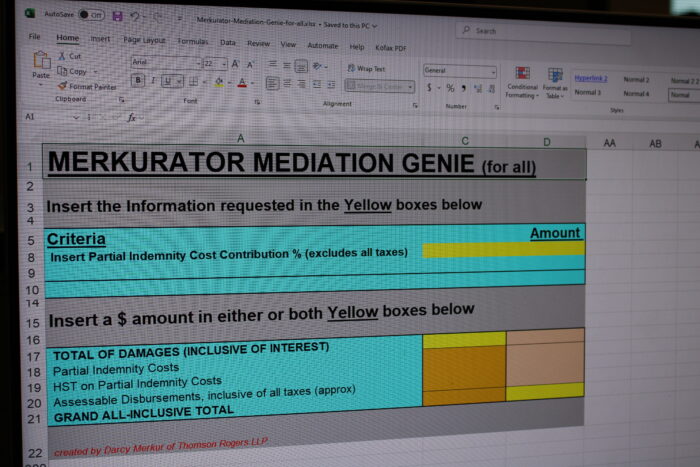Three Key Tips To Completing The Disability Certificate (OCF-3)
Author(s): Darcy R. Merkur
May 11, 2020

Anyone injured in any way by a motor vehicle in Ontario must complete and submit a Disability Certificate (OCF-3) in order to qualify for important benefits.
If you have retained a trauma lawyer to assist you then the trauma lawyer will help ensure that the Disability Certificate is properly completed and submitted on your behalf.
If you are coordinating the forms on your own here are 3 important tips.
Tip #1 – Be consistent when describing the accident
Just like the Application for Accident Benefits (OCF-1), Part 3 of the Disability Certificate again asks the claimant to describe the accident. It is crucial that this information is consistent with the information you put in the Application for Accident Benefits (OCF-1). We suggest you use the exact same vague summary about the accident or, better yet, say “See OCF-1.” If you describe the accident differently, then the lawyers in the lawsuit will compare what you have put on each of the forms and see if there are any significant distinctions.
Tip #2 – Make sure the list of injuries is comprehensive
While the claimant completes and signs the first part of the Disability Certificate, the health provider is then responsible for completing the balance of the form. It is crucial that the provider completing the form lists all of your injuries in Part 5 of the Disability Certificate. All too often these Disability Certificates are completed by somebody like a chiropractor who will focus and list only the injuries of concern to them. Insurance defence lawyers use omissions from these forms to their advantage so please encourage the provider completing the form to list all possible injuries including any possible brain injury. A family physician is usually best equipped to complete the Disability Certificate, but they have very limited time to do so. In the event that you have sustained a concussion it is important that it is referenced as otherwise the omission of a concussion reference will result in a suggestion by an insurer or their lawyer that a concussion was not present from the outset. The insurance company is using the information in the Disability Certificate to determine whether the injuries sustained fall within the Minor Injury Guideline (i.e. whiplash type injuries) where only modest benefits would be available, and if the injuries you sustained are more serious, then you want to be put in the higher non-catastrophic injury category from the outset in order to access enhanced benefits.
Tip #3 – Answering the Weekly Benefit questions correctly
Part 6 of the Disability Certificate asks questions about the claimant’s ability to work and whether they have suffered a “complete inability to carry on a normal life”. The answers to these questions are relied on by the insurance company to determine their obligation to pay weekly benefits like income replacement benefits or non-earner benefits. There are also questions about how long the person will be unable to work and the insurer will be surprised if the person cannot work for a longer period than originally set out. As a result, where appropriate it is best that the provider list “more than 12 weeks” in terms of the probability of when you might return to work and explain that it is still unclear how the person’s health will evolve such that a further review is required in the weeks to come before any return to work would be complicated. In addition, there is a question on the form about “does the applicant suffer a complete inability to carry on a normal life?” This question is based on the person’s status as of the date the form is being completed! If the claimant is currently immobile then the provider should be able to confirm that at that time, the person has sustained a complete inability to carry on a normal life. Answering “yes” to this question potentially qualifies the unemployed applicant to non-earner benefits payable at a rate of $185 per week. Wherever possible the claimant should try to review the Disability Certificate before it is submitted to the accident benefit insurer to make sure it is done properly, but notoriously the providers send the completed form to the accident benefit insurer along with an invoice without allowing the claimant to review it for accuracy.
At Thomson Rogers we pride ourselves on helping people through a very difficult period following a car accident. If you have had a prolonged stay at a hospital following a car accident and would like a free no obligation consultation, please contact the Trauma Lawyers at Thomson Rogers.
Darcy Merkur is a highly regarded Ontario trauma lawyer helping accident victims such as pedestrians, cyclists and motorists, who have sustained catastrophic injuries.
Darcy is one of just four plaintiff’s personal injury lawyers in Ontario recognized as a Certified Specialist in Civil Litigation by the Law Society of Ontario, listed in peer-reviewed publications – Lexpert®, The Best Lawyers™ in Canada, AV pre-eminent Martindale-Hubbell ® and is a partner at Thomson Rogers, one of Canada’s Top 10 Personal Injury Law Firms as selected by Canadian Lawyer Magazine.
Darcy can be reached at 416-868-3176 or by EMAIL.
Share this






